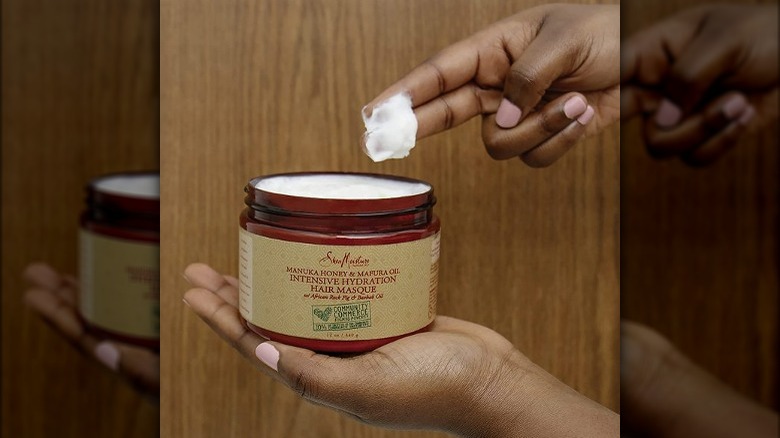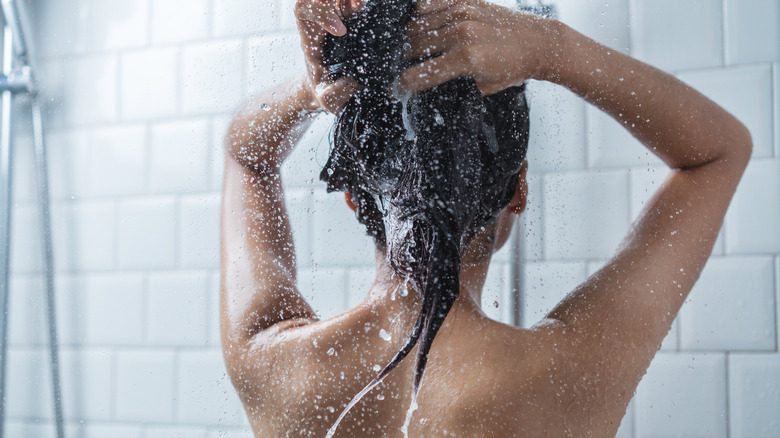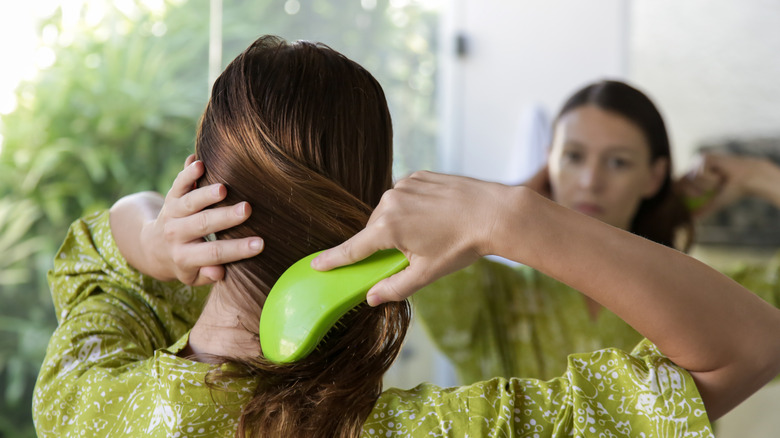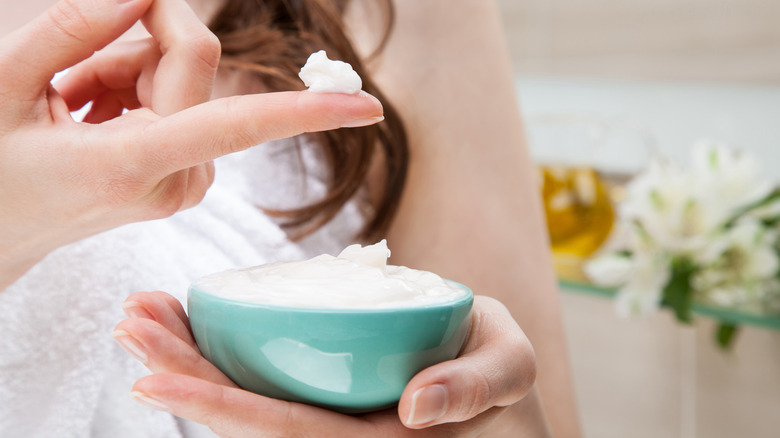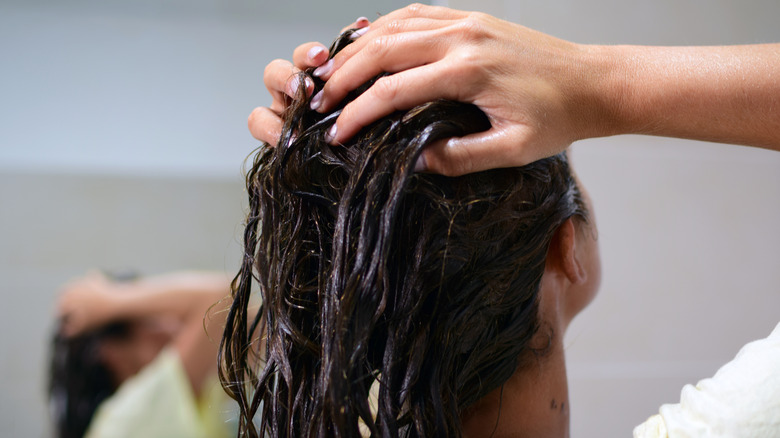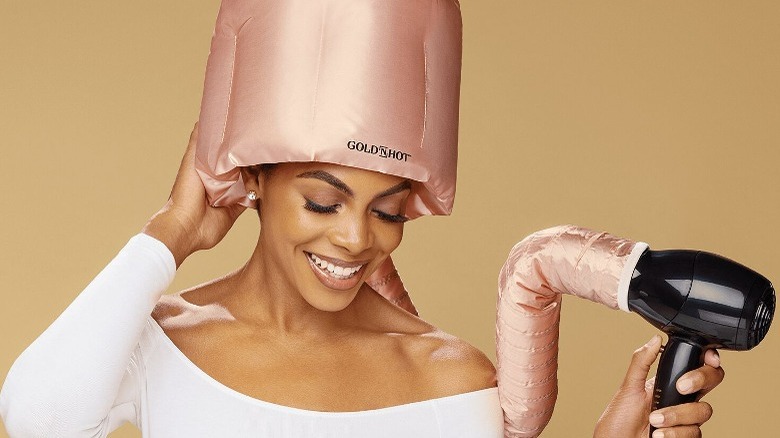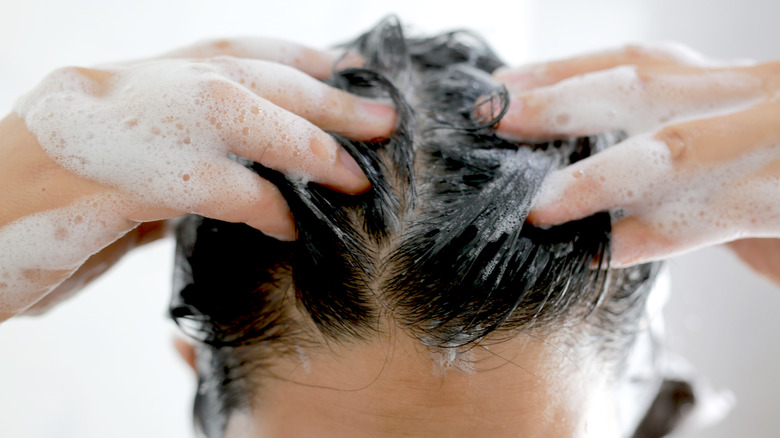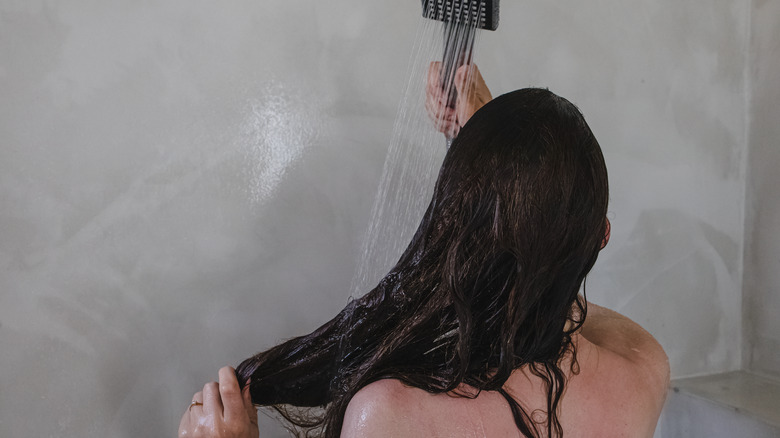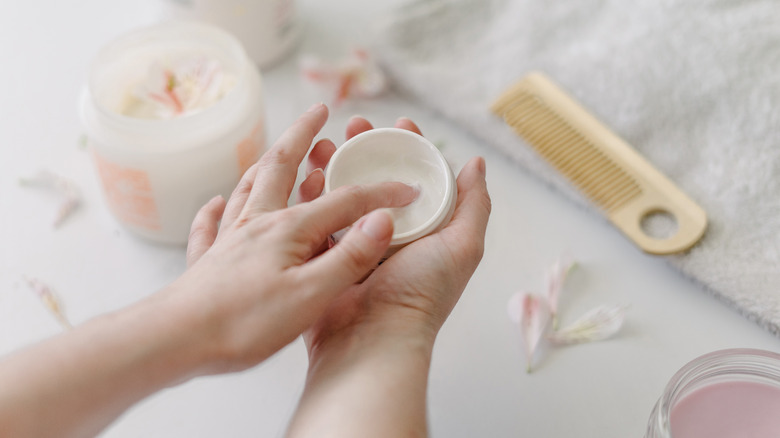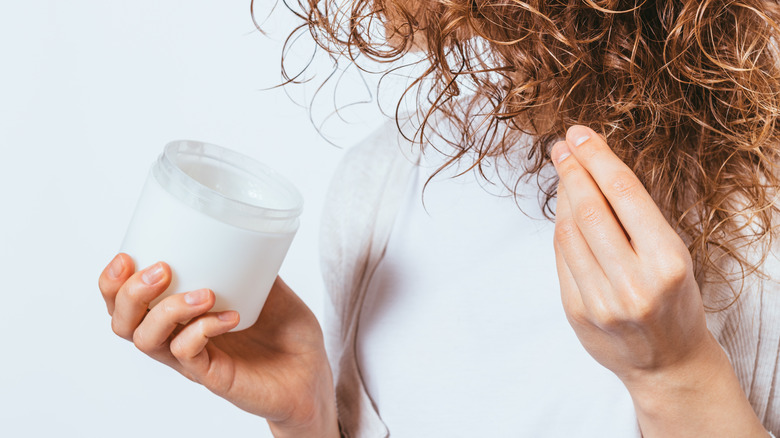Mistakes You're Making When Deep Conditioning
Almost anyone's hair can be made shinier, stronger, and healthier with the help of a regular deep conditioning routine. Deep conditioners, which are sometimes called hair masks, are typically formulated with plant-based butters, hydrolyzed proteins, and hydrating oils that coat and penetrate the hair shaft. Yet, it's difficult for your hair to receive all the good things a deep conditioner wants to provide it with if you're using it wrong. Despite its wonderful capabilities, many mistakes can be made with this type of product.
Whether your hair is damaged, dry, straight, or curly, a deep conditioner can help, but only if you know what you're doing. There are a few steps you must take to prepare before applying the conditioner, some things to remember while it's in your hair, and a couple more factors to think about when rinsing it out. Thankfully, you don't have to do much of your own research. If you know your hair type already, this guide, along with the instructions on the deep conditioner you chose, will help you deep condition your hair properly for softer and more manageable locks.
Using the wrong deep conditioner for your hair type
Most deep conditioners are protein-based or moisture-based. As the names imply, protein-based deep conditioners are used to strengthen the hair and minimize breakage, while moisture-based options are meant to hydrate your locks. Depending on your hair type, one of these will certainly be better for your hair compared to the other. In general, moisture-based deep conditioners give curly and textured hair the slip for detangling and essential moisturization for maintaining healthy strands. Products such as the Shea Moisture Honey & Mafura Oil Intensive Hydration Hair Masque are great for this hair type as well as thick and dry hair.
Protein-based deep conditioners should be used on damaged strands that have withstood several rounds of chemical treatments, hair dye, and hot tools. In addition to moisturizing, a conditioner like Briogeo's Don't Despair, Repair! Hair Mask can heal brittle and over-processed hair with ingredients like algae extract and rosehip oil. Unlike a moisture-based deep conditioner, this type aims to heal your strands without weighing them down, especially if you have straight or wavy hair.
Not removing build-up before deep conditioning
Choosing to forgo a thorough shampooing before using a deep conditioner is like mopping your floors before sweeping. All it does is move around the dirt and grime, making it harder to remove than when you started. In addition to this, it also makes the deep conditioner less effective because it can't penetrate your strands very well when they're covered in oil or product build-up.
Before using a deep conditioning treatment, you should always shampoo your hair to remove any hairspray, gel, dust, or excess oil. Normally, any quality shampoo will do the trick. However, if you really want to receive all of the benefits of your deep conditioner, consider purchasing a clarifying shampoo or a chelating shampoo. Clarifying shampoo is formulated to remove product build-up from your hair, and it's more gentle than a chelating shampoo. Soapbox's Tea Tree Clean & Purify Shampoo is one great option and it can even be used along with their deep conditioner, the Tea Tree Soothing Hydration Hair Mask, to reset your hair's hydration. A chelating shampoo is for those who have serious build-up typically caused by hard water and swimming in chlorinated pools. Using this type of shampoo every once in a while can help to bring your locks back to square one before deep conditioning.
Forgetting to detangle your hair beforehand
As many folks with textured hair already know, detangling your hair before or during the deep conditioning process is essential. Of course, depending on your hair type, you may need to detangle your hair while it's still dry for the best results. Straight and wavy hair is less likely to fall victim to breakage if it is gently combed through before wetting or shampooing, while textured hairs must be wet and slathered with conditioner to provide some slip while going to work with a comb.
Either way, detangling is a must. Trying to shampoo tangled hair almost always leads to more knots as you lather your hair. With a wide-toothed comb, you should detangle your tresses in sections. Start at the ends and carefully work your way up to your roots. If you have thick or textured hair it's best to pin back or twist each of the detangled sections as you go so you don't have to go back and re-comb them later. Once your strands are tangle-free you can go in with your conditioner, if you haven't already, which will smooth and soften your hair even further.
Using too little or too much deep conditioning treatment
When it comes to deep conditioning, it's difficult to use too much product at once. Truth be told, even if you were to use the entire tub, much of the conditioner would simply wash out of your hair. Still, we don't recommend using an overabundance of deep conditioner on your strands as most of these treatments aren't cheap. Use as much as you want, but try to be mindful not to unnecessarily waste the product.
Not using enough deep conditioner is the thing to worry about. For the best results, you want to make sure your tresses are generously saturated with your conditioner. If your hair is very thick or curly, you might consider sectioning it into four or more parts to keep track of the treated and untreated areas. Use your fingers or a wide-toothed comb to distribute the product through your hair and add even more to your dry ends. After deep conditioning, you'll be able to tell if you missed some spots because they won't feel as soft or look as smooth as the properly treated strands which is why it's essential that you use the right amount of product the first time.
Leaving the product on longer than you are supposed to
Even though using too much deep conditioner won't cause any issues, leaving it on for too long can. Believe it or not, it's possible to over-condition your hair. There's even a fancy term for it: hygral fatigue. Hygral fatigue is caused by introducing excessive moisture to your hair follicles again and again, which makes them swell and un-swell. This damages the follicles and makes them more brittle and frizzy, effectively doing the opposite of what you were trying to fix in the first place.
Some people will leave in their deep conditioner overnight, assuming that if they leave the product in their hair longer, it will work better. This is a fair assumption, but unfortunately, deep conditioners don't work that way. Reading the instructions on these types of products is necessary to get the most out of them. They are researched and formulated to give your hair exactly what it needs.
Not deep conditioning on a schedule that's right for your hair type
Similar to leaving in your deep conditioner for too long, it's also possible to deep condition your hair too often. Every hair type can benefit from a good deep conditioning, but not everyone should be using it twice or even once per week. If your hair is fine, naturally straight or wavy, and relatively healthy, you may only need to use a deep conditioner once per month to keep it balanced and frizz-free. Overusing your deep conditioner may make your strands feel weighed down or greasy.
On the other hand, thick or textured hair can go through this process much more often. Thick hair should be deep conditioned one or two times per week. The conditioner helps keep thick locks manageable and soft, reducing tangles and frizziness. For textured hair, regular use of this product can make your curls easier to care for on a daily basis. It's recommended to use a deep conditioner on curly hair each time or every other time you wash your hair depending on your hair concerns and how your wash schedule is already set up.
Applying the product to the wrong parts of your hair
A deep conditioner can be applied in a multitude of ways. Damaged, straight, oily, textured, or brittle hair can be treated with a different method to reap the benefits of this penetrating product. Based on your hair concerns and your hair texture, you might want to apply more of your deep conditioner to your ends than your roots or vice versa. Most people using a deep conditioner are looking to deposit additional moisture into their hair to make it less brittle and easier to work with. However, depending on your hair type, you'll want to apply the product differently.
Those with highly porous hair should be distributing their deep conditioner from their roots to the tips of their strands, making sure that their roots are fully soaked with the product before moving on to the next steps of the process. Yet, fine and less porous hair will need much less conditioning at the root, if any at all. Such is the case with using your normal conditioner, thin hair that is straight or wavy is easily weighed down by excess moisture and is prone to faster build-up. So, your deep conditioner should only be used on the mids and ends of the hair shaft to avoid flat and overly hydrated roots.
Not adding heat to your deep conditioning routine
It isn't a must, but adding heat to your deep conditioning routine can really make a difference in how your hair retains the benefits of the product. High porosity hair is typically dry and easily tangled. While it easily absorbs moisture, it also has trouble retaining it, so it feels like you are constantly adding oil and other hydrating products to quell its thirst. One way to help your deep conditioner make a difference is to open your hair cuticles with heat. This allows the conditioner to penetrate even deeper into your strands.
Surprisingly, low-porosity hair, which has trouble absorbing moisture, can be aided by heat, as well. This hair type, which is usually straight or wavy, won't let the product in, so it simply sits on the hair causing build-up. As the cuticle opens up with the heat, the deep conditioner can make its way into the hair to do its job. Low heat can be introduced to your strands with a heat cap. Today there are many different types including microwavable caps, electric thermal caps, and the traditional bonnet with a dryer attachment like the Gold 'N Hot Bonnet Dryer Attachment available at Sally Beauty. All of them essentially do the same thing, so you can choose yours depending on your preference.
Shampooing your hair after deep conditioning
It's not the end of the world if you shampoo your hair immediately after deep conditioning it, but doing so may reverse all the good things the product just did for your strands. Using deep conditioning treatments can take a lot of time and planning. From waiting for the conditioner to do its thing to setting up your heat cap to make it work even better, the process can take hours from the time you detangle your hair until you finally wash out the deep conditioner. Why would you want to risk washing out all that hard work?
You should always shampoo first and deep condition last. As mentioned previously, you want to use your shampoo to cleanse your strands and rid them of excess oils, built-up hair products, and any dirt or debris hiding in them. After your tresses are squeaky clean and likely quite dried out from shampooing, you can apply a generous amount of deep conditioner to the thirstiest parts of your hair to restore all of that lost moisture. Your deep conditioner will also usually add some extra vitamins and protein to combat all the other tribulations you've put your hair through throughout the previous days, weeks, or months.
Rinsing out your hair with hot water
Hot water is never very good for your hair or for your skin for that matter. The heat of the water may feel good on your cold body and scalp, but you might not realize how drying it can be. Hot water irritates and dehydrates all parts of your body including your hair, skin, and nails that you are so diligently trying to care for. Simply turning the heat down can reduce your acne, thicken your hair, and make your skin smoother.
When using a deep conditioner, your goal is to heal, strengthen, and hydrate your hair. However, rinsing it out in hot water can lead to stripped hair strands prone to frizziness and breakage from damaged cuticles and broken protein bonds. If you switch to cool or even lukewarm showers, the temperature of the water will not only keep your hair from becoming stripped, but it can also close the hair follicles and lock in moisture so your hair is shiner, stronger, and free of frizz. It's important to note that warm water is sometimes necessary to wash your hair and rid it of excess oils and grime. Consider washing your hair and body in a warm shower and make it colder while you're conditioning to hold in more of the moisture at the end.
Applying moisturizing products after using a deep conditioner
Over-conditioning your hair is a real thing that you want to avoid no matter what type of hair you have. Not only can your hair develop hygral fatigue from leaving your deep conditioner in for too long, but it can also occur from using too many conditioning products at once. People with highly porous hair need to be watching out for this the most because the cortex of their strands is easily reached through the spaces between their hairs' cuticles. Some of the symptoms of hygral fatigue include tangles, frizz, dullness, brittleness, breakage, and a gummy texture of the hair strands.
One common way that people over-condition their hair without realizing it is by over-using conditioner, deep conditioner, hair oils, and leave-in treatments. Unfortunately, as the hair becomes more frizzy and brittle from hygral fatigue, some people assume that they need more of these hydrating products to combat it, which only damages the hair even further. Following the instructions on your moisturizing hair treatments and using them as directed will usually help you avoid this type of fatigue and maintain healthier hair.
Applying deep conditioner to wet hair
As we've learned so far, there is a right way to use a deep conditioner. However, the "right way" for one person may not be the best for another. The best way to deep condition your hair is dictated by your hair type, texture, and concerns. Someone with fine and straight hair will not benefit from deep conditioning their hair the same way that a person with thick and curly tresses will. Still, there is one technique that may benefit all hair types that's worth a try.
Nearly all deep conditioning instructions tell users to apply the conditioner to wet hair. This makes perfect sense as most conditioners are supposed to be used on wet hair to help it become distributed over your entire head of hair. Yet, maybe we've all been deep conditioning wrong suggests Yale University's Dr. Mona Gohara, who says that applying deep conditioner to dry hair may create better results. She says that using water with the conditioner causes the product to become watered down and less of it is absorbed into the hair shaft. Deep conditioner alone can do a better job at penetrating dry ends and damaged strands to heal your hair before rinsing it out. Still, keep in mind that using a deep conditioner on dry locks might be blocked anyway by product buildup and natural oils as well as dirt or debris from your regular activities. Try it out yourself to see if your hair responds better to deep conditioner when it's dry or wet.

